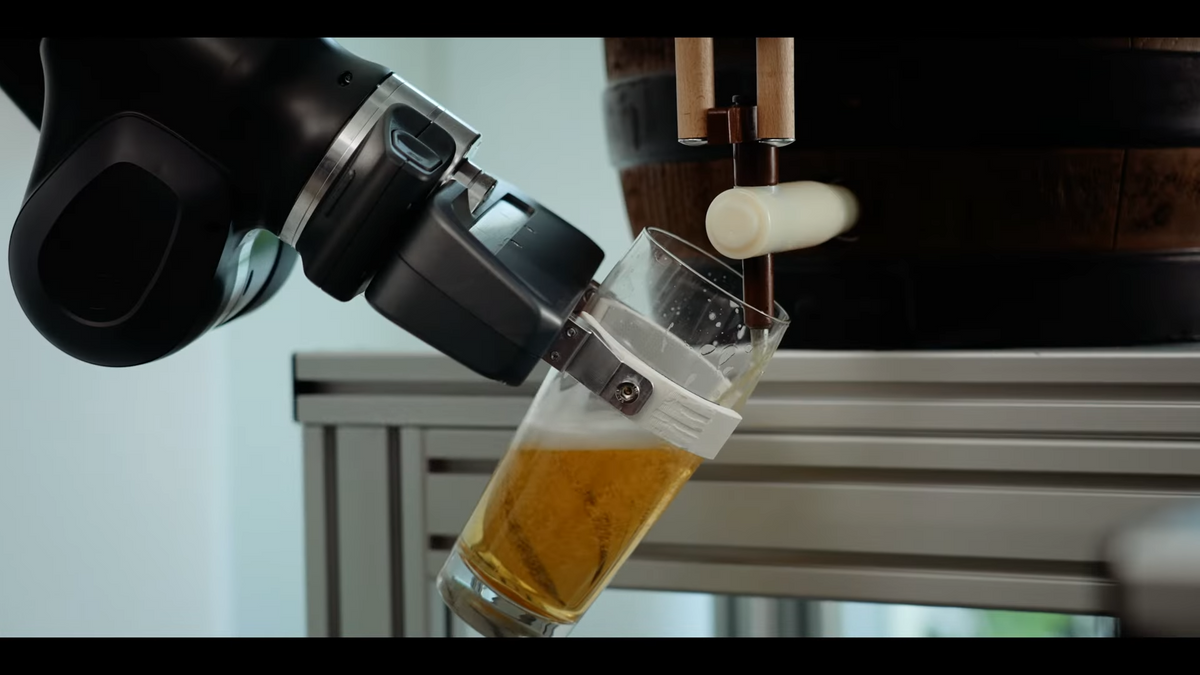Video Friday is your weekly selection of awesome robotics videos, collected by your friends at IEEE Spectrum robotics. We also post a weekly calendar of upcoming robotics events for the next few months. Please send us your events for inclusion.
IROS 2022: 23–27 October 2022, KYOTO, JAPAN
ANA Avatar XPRIZE Finals: 4–5 November 2022, LOS ANGELES
CoRL 2022: 14–18 December 2022, AUCKLAND, NEW ZEALAND
Enjoy today’s videos!
Pouring the perfect Octoberfest beer requires a humanlike sense of touch and dexterity, precision and force control. Franka Production 3 has it all!
[ Franka Emika ]
First time, I’m sure.
[ Tech United ]
A team led by the University of California, San Diego, has developed a new system of algorithms that enables four-legged robots to walk and run on challenging terrain while avoiding both static and moving obstacles. The work brings researchers a step closer to building robots that can perform search-and-rescue missions or collect information in places that are too dangerous or difficult for humans.
[ UCSD ]
Thanks, Liezel!
SusGrip is a new smart gripper from Apicoo Robotics with a compact size and long stroke. The gripping motion is parallel, making it is easy and intuitive to use. An absolute encoder is equipped so users can instantly use the gripper without calibration.
[ Apicoo Robotics ]
Thanks, Vo Gia Loc!
This is both brilliant and, somehow, terrifying.
[ Gazing Car ]
Robots away!
[ Recon Robotics ]
Robot friends, as it turns out, are very expensive.
[ RoboDesign Lab ]
We present a “Kinegami” algorithm that converts a Denavit-Hartenberg specification into a single-sheet crease pattern for an equivalent serial robot mechanism by composing origami modules from a “Tubular Origami Catalogue.”
[ Kod*lab ]
PIBOT2 makes flying a (fake) airplane look easy.
[ USRG ]
GITAI USA Inc. wishes God Speed for JAXA Astronaut Dr. Koichi Wakata, Expedition 68 Crews, and SpaceX Falcon 9!!
[ GITAI ]
We’re excited to announce that Reachy gained mobility with a new mobile base, but also [has] improved software and hardware. Pollen Robotics’ engineers developed new features including VR teleoperation compatibility and the Lidar technology to ensure robot safety.
[ Pollen Robotics ]
As Starship robots carry out their deliveries, they naturally might need to cross a road. The robots are equipped with a suite of sensors and cameras which are constantly understanding the environment around them. This means they only cross roads when it is deemed safe to do so. Have a look at this technology in action.
[ Starship ]
Mauser Packaging Solutions needed a material-handling automation solution that would meet uptime and throughput requirements. By making the switch to OTTO 1500 AMRs, Mauser increased uptime, improved worker safety and enhanced throughput by 600%.
[ OTTO ]
Discover the Navigation2 applications for ROS2 allowing TIAGo robot to navigate autonomously in indoor spaces and with mapping.
[ PALRobotics ]
In one of our first pilots for C.H. Robinson customers, we autonomously moved 1M+ pounds of freight for Constellation Brands from Dallas to Houston. Pilots like these will shape the future development of the Waymo Driver and expansion of our Waymo Via trucking solution.
[ Waymo ]
We have seen great advances in artificial intelligence in recent years. To HAI Distinguished Fellow Peter Norvig, as an AI practitioner and educator, this raises two questions: First, what do learners need to know about AI (and machine learning and data science) today, and how can they best learn that? Second, how can the technologies of AI be used to facilitate learning in all subjects?
[ Stanford HAI ]
This Maryland Robotics Center seminar is from UC Berkeley’s Hannah Stuart, on “Embodying Dexterity: Contact models for the design of robotic grasping and manipulation.”
For robots to perform helpful manual tasks, they must be able to physically interact with the real world. In this talk, I will introduce how my lab is developing tools for “messy” or adversarial contact conditions—granular/rocky media, fluids, human interaction—to support the design of more capable systems.
[ UMD ]
Evan Ackerman is a senior editor at IEEE Spectrum. Since 2007, he has written over 6,000 articles on robotics and technology. He has a degree in Martian geology and is excellent at playing bagpipes.



